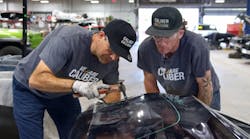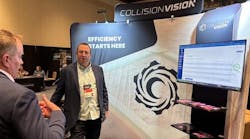Frank Iantorno has worked in the Information Technology field for the past 36 years, spending a majority of his time on the creation and implementation of standards across the collision industry. He came to the industry in 1985 when he joined a leading auto-glass replacement and repair company, first in the area of shop automation then in eCommerce. He is responsible for starting the Property and Casualty ANSI X12 committee in the late 1980s, which has helped to develop Electronic Data Interchange (EDI) standards. Iantorno became a founding member of the Collision Industry Electronic Commerce Association (CIECA) in 1991 and remained a member until accepting the position of executive director in 2002. CIECA’s vision is to establish an eCommerce-enabled collision industry, allowing all industry segments to communicate electronically, independent of platform or software used. Here, he explains why CIECA is an integral part of the collision industry and how the company envisions the future of eCommerce.
What is the biggest eCommerce challenge that shops are currently facing, and how does CIECA plan to address this obstacle?
One of the biggest issues facing the shops today is the continued use of the legacy EMS standard. The EMS (Estimating Management Standard) is vintage 1999: before Y2K, before the turn of the century. It is not only built with old technology, but it has not been kept current with the data and informational requirements of today’s business environment.
Today, there is a greater need for security and privacy. Also, there is a business requirement for greater efficiency and greater administrative savings. The EMS does not allow for this. The replacement upgrade to it is the BMS (Business Message Specification), which CIECA has been publishing, enhancing, and maintaining since 2004. If you use PCs or Macs, servers or mainframes, BMS data can be exchanged without problem since it is written in XML. XML is the natural language of the Internet. As such, exchanging XML data is straightforward.
The BMS is currently in use within the insurance, salvage, and procurement sectors; however, the information providers have not upgraded their shop systems and programs to include it for repairers. CIECA has addressed this with the information providers but progress is slower than anticipated. It is an uphill battle. CIECA is hopeful that 2009 will see some movement in this area. Repairers should contact their information provider and tell them that they want the new BMS implemented in their shop systems.
What is the greatest advancement the industry has made in terms of eCommerce?
The first was the creation of CIECA. Creating an organization to singularly focus on developing business transaction/message standards was a huge step in advancing eCommerce within the industry.
Second was the development of the BMS. The legacy CIECA EMS is limited in the data that is exchanged. Today’s business environment requires more data than exists in the EMS. The new business requirements, such as status, glass, car rental, parts procurement, require shops to enter data manually into different systems; this manual key-entry is expensive. The BMS addresses these new requirements. Implementing the BMS will save the industry time and money.
Third was the collaboration that CIECA initiated with AAIA, ARA, ACORD, ASPA, and STAR. This expands the scope and reach of the CIECA standards and insures that the collision industry can communicate with those other industries we deal with regularly.
What is important for shop owners to know about CIECA?
That a lot is being done by CIECA on their behalf. We are currently working to reduce the burden that new business requirements have created for repairers (visit cieca.com/CIECAUniversity/XML/EMS-BMS-Migration to learn more about the requirements). For example, the reporting of the status on the insured’s vehicle—we are automating the status process and have a committee fully focused on addressing this issue. This committee meets weekly until they accomplish their goal.
CIECA also created the Repair Advisory Panel (RAP) to solicit direct input from repairers. This panel meets twice a year (January and July) during CIC meetings. The ShopAssist program was developed as a result of the RAP. If a repairer plans to attend CIC, I welcome their participation with RAP.
How will the new CIECA ShopAssist help repairers?
[It has] better and more accurate tools to help shops automate their systems. [It will also] enhance the process for their IT staff people or consultants to understand the systems and products that are required for a successful repair facility.
How does CIECA work to better facilitate communication between all collision industry partners?
By understanding the processes involved, understanding the data requirements, creating a better process, and then automating the components within that process. We manage the entire process from building awareness in the industry of the developments, gaining the right participants to lead the effort, and, then, providing the resources and talent to make it a reality.
Getting everyone, i.e., all stakeholders, involved results in better standards and better processes for all.
How important is electronic commerce becoming in the collision industry?
Technology and electronic commerce is extremely important, and it is growing in importance each day. The costs of manpower to complete the manual processes of today, and to resolve the errors created by those processes, is ever growing. Implementation of technology coupled with the decreasing cost of technology create a strategic and tactical advantage in all organizations. Implementing technology and electronic commerce will save money for the industry as a whole.
What kind of resources does CIECA offer for shop owners and operators who would learn more about eCommerce or have a better grasp of technology?
Our newly implemented CIECA University (cieca.com/University.htm) offers 24/7 training sessions on everything from “What is CIECA working on?” to “How to Read a XML Schema.” More courses are being added monthly. There is also a form for anyone to suggest a course topic. Each suggestion is considered. Additionally, participation on a committee will give them hands-on knowledge of what goes into the process and why people put long hours into these developments.
For shop owners wary of new technology, what advice do you suggest for feeling more comfortable using it?
Do not fight technology. It is here to stay. Do not hand it over to someone else. Someone else may do the work for you, but you need to be involved and stay involved. If you do not have an IT staff or person, hire a technology consultant that you trust to explain the process, someone that will take the time to share with you the options, benefits, and ongoing improvements, as well as the challenges.



